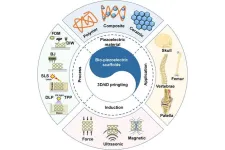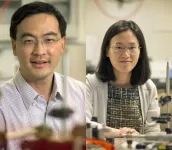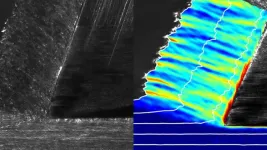(Press-News.org) Piezoelectricity in native bones has been well recognized as the key factor in bone regeneration. However, the current additive-manufactured scaffolds mainly focus on the reconstruction of bionic topological structure and mechanical microenvironment, while the crucial electrical microenvironment (EM) in bone regeneration is neglected. Piezoelectricity in native bones has been well recognized as the key factor in bone regeneration. However, the current additive-manufactured scaffolds mainly focus on the reconstruction of bionic topological structure and mechanical microenvironment, while the crucial electrical microenvironment (EM) in bone regeneration is neglected.
The research, published in International Journal of Extreme Manufacturing (IF: 14.7), shows the enormous potential of 3D/4D printing of bio-piezoelectric scaffolds for next-generation bone tissue engineering.
There is a significant gap between the capabilities of the present 3D/4D printing techniques and the clinical application requirements of bio-piezoelectric scaffolds. Its great development requires a joint effort of multidisciplinary studies, including materials science, mechanical engineering, and bioengineering. Its widespread adoption should also draw inspiration from some cutting-edge technologies such as intelligent manufacturing, bionic medicine, and machine learning.
"In principle, this opens up the design and fabrication of a smart biological piezoelectric scaffold that promotes bone repair by mimicking the tissue's crucial electrical microenvironment,” said Annan Chen a postdoctoral fellow at the City University of Hong Kong and the first author on the study. "Essentially, it offers new enlightenment toward a potential breakthrough in building smart scaffolds for next-generation bone tissue engineering," said Prof. Chunze Yan, a professor at the Huazhong University of Science Technology, and Prof. Jian Lu, a Chair professor at the City University of Hong Kong.
This piezoelectricity has been demonstrated in human bones, which generate positive and negative charges when subjected to compression or tension. For instance, the human tibia can generate a piezoelectric potential of ~300 μV during walking. Therefore, piezoelectric materials show unique advantages in simulating the EM of bone tissues, which can significantly promote the metabolism of cells and new bone formation. The surface charges of piezoelectric materials can attract ions to promote cell adhesion through ion or charge interaction, as well as activate growth factor expression to improve cell proliferation and osteogenic differentiation.
The additive-manufactured bio-piezoelectric scaffolds can reconstruct desired tissue EM through a non-invasive ultrasonic stimulation. This time-dependent functionality-shifting behavior of 3D structures when exposed to external stimulus, also is defined as four-dimensional (4D) printing. This new 4D functionality-shifting bio-piezoelectric scaffolds can provide a time-dependent programmable electrophysiological microenvironment in response to external stimuli for tissue regeneration.
However, there is a significant gap between the capabilities of the present 3D/4D printing techniques and the clinical application requirements of bio-piezoelectric scaffolds, and more efforts are needed to completely close this gap. In fact, the 3D/4D printing of bio-piezoelectric scaffolds fully integrates the benefits of multiple disciplines such as materials science, mechanical engineering, and bioengineering, scientists thought its great development had to require a multidisciplinary joint effort.
Then Chen began experimenting with some lead-free biological piezoelectric materials discovered years ago, but largely ignored. He focused on the material-topography-biofunctionality intergated 3D/4D printing of bio-piezoelectric materials for advanced biological applications.
To the scientists' astonishment, the bio-piezoelectric materials showed excellent processability and biocompatibility. What's more, they were multicellular inducible. "We found that their electrical microenvironment can induce bone cell differentiation, promote vascular cell recruitment and nerve cell repair," said Chen. That has great potential for clinical applications.
But for clinical medicine, the most striking thing was that the reconstitution strategy of the bio-piezoelectric scaffold was minimally invasive or non-invasive. "Upon programmable ultrasound or magnetic treatment as a remote mechanical stimulus, the on-demand in vivo electrical stimulation with an adjustable timeline, duration, and strength can be delivered," said Yan.
Chen, Yan, Lu, and their lab worked with other scientists around the university to try to combine the advantages of multiple disciplines to promote the 3D/4D smart piezoelectric biological scaffolds in more medical applications. "We are carrying out cooperative research with experts in orthopedics, stomatology, oncology and other fields, and achieved the expected research results," said Chen.
Over the years, 3D/4D printing technology has incorporated many advantages observed in traditional production techniques. Although it is still a long way to go from bench side to bedside, the team expresses optimism about the future of 3D/4D printing. “The 3D/4D printing of bio-piezoelectric scaffolds fully integrates the benefits of multiple disciplines such as materials science, mechanical engineering, and bioengineering, its great development requires a multidisciplinary joint effort, " said Professor Lu.
“With the collaborative efforts of multidisciplinary studies, 3D/4D printing would be expected to soon reach its full potential in creating smart bio-piezoelectric scaffolds for next-generation tissue engineering. Besides, we also can draw inspiration from some cutting-edge technologies such as intelligent manufacturing, bionic medicine, and machine learning, to further promote the clinical application of this technology”.
About IJEM:
International Journal of Extreme Manufacturing (IF: 14.7, 1st in the Engineering, Manufacturing category in JCR 2023) is a new multidisciplinary, double-anonymous peer-reviewed and diamond open-access without article processing charge journal uniquely covering the areas related to extreme manufacturing. The journal is devoted to publishing original articles and reviews of the highest quality and impact in the areas related to extreme manufacturing, ranging from fundamentals to process, measurement and systems, as well as materials, structures and devices with extreme functionalities.
Visit our webpage, Like us on Facebook, and follow us on Twitter and LinkedIn.
END
3D/4D printed bio-piezoelectric smart scaffolds for next-generation bone tissue engineering
2023-07-19
ELSE PRESS RELEASES FROM THIS DATE:
Study identifies how diabetes slows healing in the eye
2023-07-19
Investigators from Cedars-Sinai have provided new understanding of how diabetes delays wound healing in the eye, identifying for the first time two related disease-associated changes to the cornea.
The findings, published today in the peer-reviewed journal Diabetologia, also identified three therapeutic pathways that reversed these changes and partially restored wound-healing function to the cornea—a discovery that could ultimately inform new treatments for diabetes.
“We have found that diabetes induces more cellular changes than we were aware of previously,” ...
Plenary closeup: Biomolecular condensates the foundation for innovations to come
2023-07-19
Biomolecular condensates, the tiny combinations of proteins and mRNA forming membrane-less compartments within cells, have big potential implications for the future of not just plants but humans. On Sunday, August 6, at 9:00 am, the #PlantBio2023 plenary “Highlights of New and Emerging Research on Biomolecular Condensates in Plants” will dive into this new field and its recent discoveries.
“It’s going to be a great way to get your feet wet and understand what biomolecular condensates are,” ...
New Black baby equity clinic helps infants and moms flourish
2023-07-19
Not being heard, not being taken seriously and being misunderstood by health care providers often describes a routine medical visit for many Black parents. For Black parents of young children, that lack of cultural understanding can lead to grim consequences for the health of the baby and mother.
According to the California Department of Public Health, Black babies in the Bay Area are two to three times more likely to be born too soon or too small or to die before their first birthday, compared to white babies. Scientific evidence points to structural racism and a systemic lack ...
Dual wavelengths of light effective against antibiotic-resistant bacterium
2023-07-19
Scientists have combined two light wavelengths to deactivate a bacterium that is invulnerable to some of the world’s most widely used antibiotics, giving hope that the regime could be adapted as a potential disinfectant treatment.
Under the guidance of project leader Dr Gale Brightwell, scientists at New Zealand’s AgResearch demonstrated the novel antimicrobial efficiency of a combination of two light wavelengths against a ‘superbug’ known as antibiotic-resistant extended-spectrum beta-lactamase E. coli.
Antimicrobial resistance (AMR) is a major global threat of ...
Learning from superheroes and AI: UW researchers study how a chatbot can teach kids supportive self-talk
2023-07-19
At first, some parents were wary: An audio chatbot was supposed to teach their kids to speak positively to themselves through lessons about a superhero named Zip. In a world of Siri and Alexa, many people are skeptical that the makers of such technologies are putting children’s welfare first.
Researchers at the University of Washington created a new web app aimed to help children develop skills like self-awareness and emotional management. In Self-Talk with Superhero Zip, a chatbot guided pairs of siblings ...
Consortium explores energy-efficient electronics and photonics
2023-07-19
The University of Texas at Arlington is part of a new consortium funded by the Department of Energy that involves the development of new technologies and college courses covering everything from radiation detection to nuclear engineering.
The grant also will help UTA develop 2D materials that can be integrated into new hand-held photonic technologies with multiple uses.
Electrical Engineering Professor Weidong Zhou and Associate Professor Alice Sun will use the five-year, $1.8 million grant to work with collaborators at UT Arlington, University of North Texas, University of Arkansas Pine Bluff, ...
Staying sharp: Researchers turn to an everyday shop tool to study how materials behave
2023-07-19
Researchers at Texas A&M University are taking a traditional manufacturing tool — metal cutting — and developing a more accessible method for understanding the behavior of metals under extreme conditions.
Metal cutting – scraping a thin layer of material from a metal’s surface using a sharp knife (not unlike how we scrape butter) – might not be the first thing that comes to mind for studying material properties. However, Drs. Dinakar Sagapuram and Hrayer Aprahamian, assistant professors ...
Bipolar disorder linked to 6-fold heightened risk of early death from external causes
2023-07-19
People with bipolar disorder—characterised by extreme mood swings—are 6 times more likely to die before their time from external causes, such as accidents, violence, and suicide, than those without the condition, finds research published in the open access journal BMJ Mental Health.
And they are twice as likely to die from somatic (physical) causes, with alcohol a major contributing factor, the findings show.
A heightened risk of an early death from any cause has been consistently reported in those with ...
Tripling in proportion of smokers’ duty free tobacco purchases in England since 2019
2023-07-19
The proportion of smokers’ duty free tobacco purchases in England has tripled since 2019, rising from just over 5% to just over 16%, but there’s been no reported change in black market purchases, reveals a time-trends analysis published online in the journal Tobacco Control.
Between 2002 and 2014, between 12% and 20% of UK adult smokers said their last tobacco purchase had been from a low or untaxed source. And smokers who buy their tobacco from low/untaxed sources—and those who switch to cheaper products—are less likely to try to quit smoking than those ...
Explore psilocybin and other psychedelics for women’s cancer distress, urge doctors
2023-07-19
It’s time to stop prevaricating and explore the use of psilocybin—the active ingredient in ‘magic mushrooms’—and other psychedelics to ease the often overwhelming distress faced by women with late stage gynaecological cancers, urge doctors in a commentary published online in the International Journal of Gynecological Cancer.
Conventional ‘gold standard’ psychotherapeutic approaches, such as cognitive behavioural therapy (CBT), take too long to change old habits and require too much stamina, suggest the authors from the University of Texas ...





